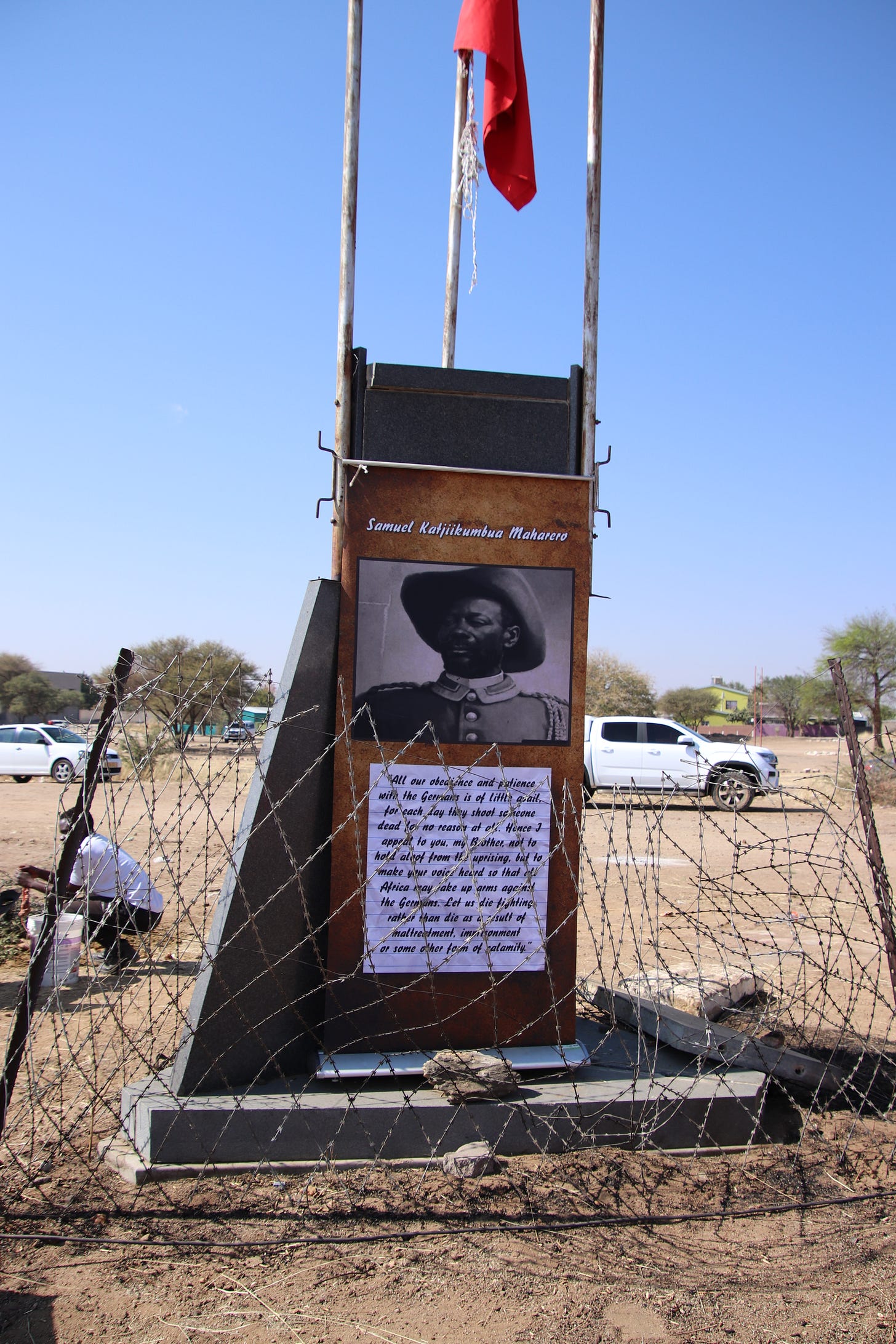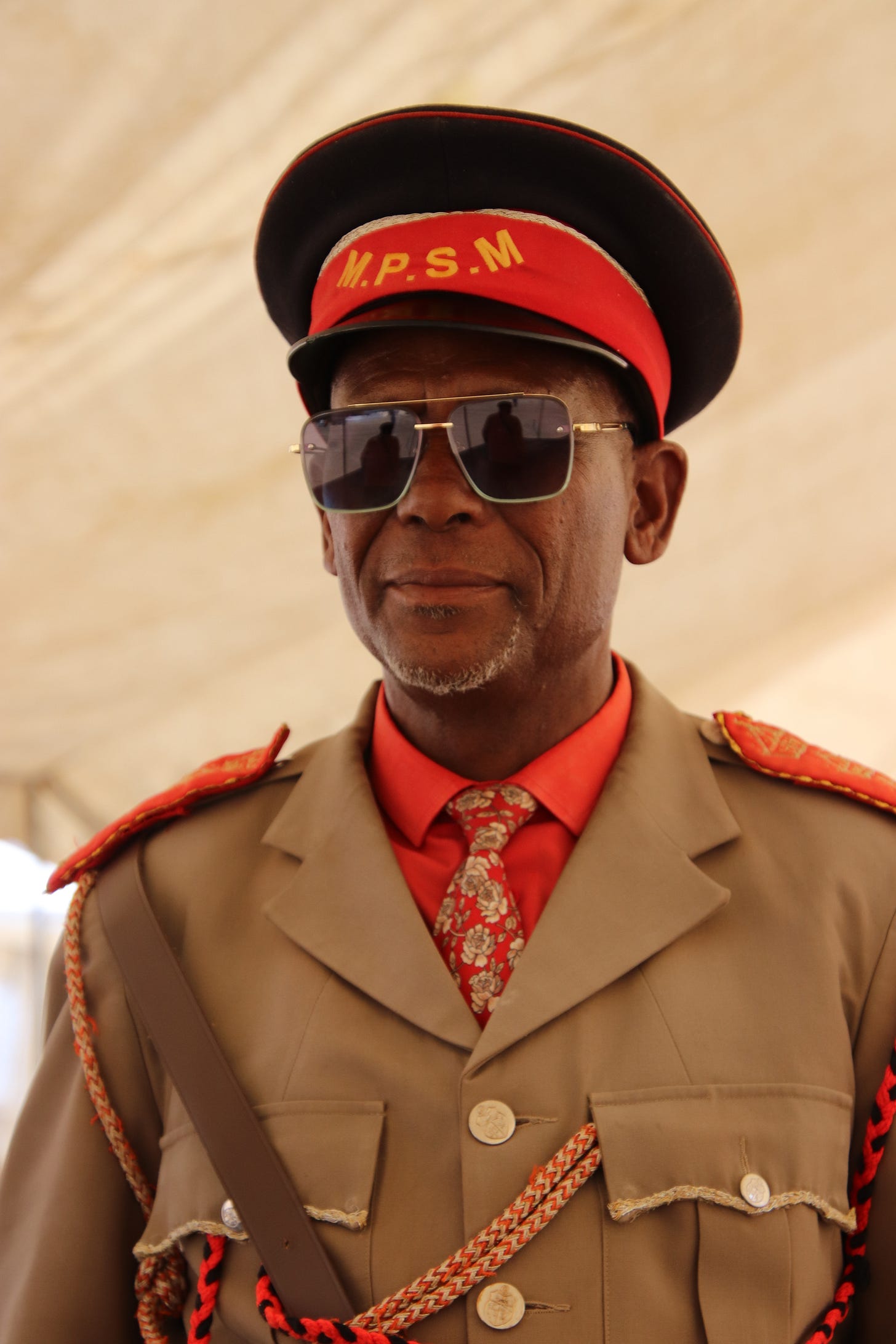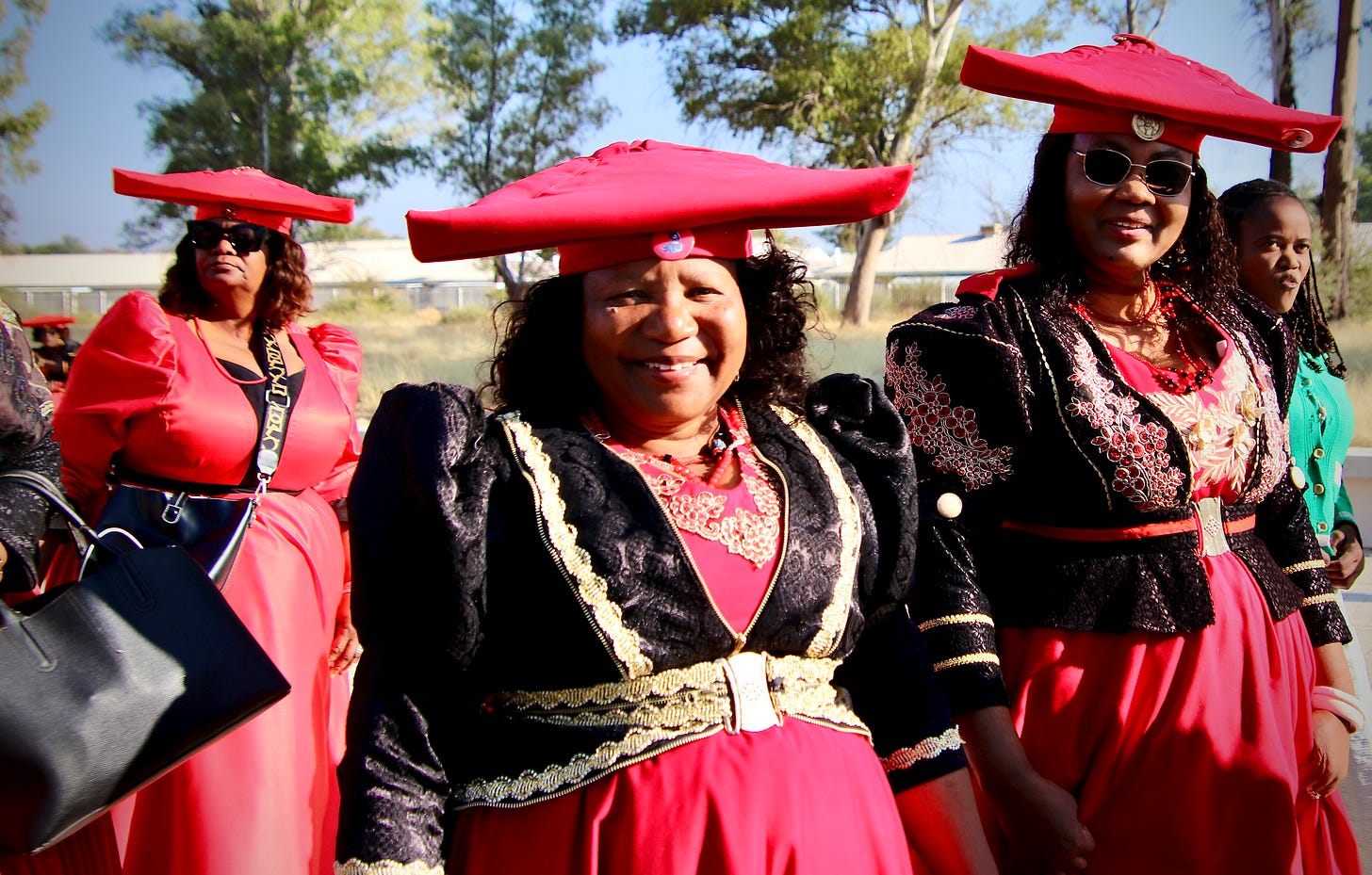Speaking with the Dead
Ritual, History, and Uneasy Politics
I arrived in Okahandja on a late Friday afternoon with Johanna Kahatjipara and her daughter Barbara. After settling into the beautiful Okahandja Country Lodge, we headed to the grounds where the weekend’s Red Flag Day ceremonies were taking place. From the start, I could tell Johanna and Barbara were no ordinary attendees. As the afternoon unfolded, both women showed themselves to be formidable figures, simultaneously respecting OvaHerero customs and gently pushing their boundaries. Everywhere we went, people greeted Johanna with deference; she is clearly revered by her peers, relatives, and community leaders.
Arrival at the Holy Fire
When we arrived at the event grounds, our first task was to pay respects to the traditional authorities. We sought out the current chief, Chief Tjinaani Maherero, a direct descendant of the famed leader Samuel Maharero, and his entourage of elders. We found them gathered beneath a canvas tent at the edge of a circle of stones that enclosed the Sacred Fire (okuruuo). Among them was the traditional leader, the elder responsible for communicating with the ancestors through the Sacred Fire.
Before we could participate any further, we needed to be welcomed by the ancestors themselves. (Quick note: terms like “traditional leader” or “tribal authority” carry heavy colonial baggage, I use them here cautiously, aware of their fraught connotations, but they are also the terms used in Namibia’s vernacular, politics, and officialdom.) Following Johanna’s lead, I knelt down in front of the traditional leader as he began to chant, calling out to the ancestral spirits and announcing our arrival. Then he took a large sip of water from a tin cup and sprayed it out in a fine mist over our faces. The sudden splash startled me, but I was told this cleansing “washing” would purify us of any potential ill-will that we might carry and even offer preemptive forgiveness for any unintended taboos we might commit in the sacred space. Barbara refused to remove her sunglasses, rightly so, which caused a bit of a stir at first. Yet again, her insistence both align and challenged customs, and eventually the elders allowed her to continue, sunglasses adorned. Thus, baptized in ancestral welcome, we were formally invited into the circle where the ancestors would be active participants in the events to come.
Once we had been “washed” into the community, Johanna, Barbara, and I took our place under the tent alongside the senior men of the community. This itself was quietly remarkable. In most OvaHerero ceremonies, especially those around the Sacred Fire, women do not sit among the male chiefs. Yet there we were, seated shoulder-to-shoulder with the chiefs. I noticed a few curious glances from onlookers at this break in protocol. But as always, Johanna and Barbara managed it gracefully, by simultaneously aligning with tradition and challenging it in subtle, good-natured ways. No one objected; in fact, I suspect Johanna’s formidable reputation had already smoothed over any ruffled feathers.
Under the tent’s shade, we chatted with the chiefs about why everyone had gathered, the meaning of Red Flag Day, the significance of this annual reunion for the OvaHerero people. As we talked, I took in the scene around us: the crowd milling beyond the tent, the crackle of the Sacred Fire, the butchered meat laying on branches just outside the Sacred Fire, and the striking attire worn by participants.
Many of the men sported crisp military-style uniforms, while the women, save for Johanna and Barbara, wore long Victorian-era dresses topped with fabric headpieces shaped like cattle horns, Otjikaiva. This wasn’t mere pageantry; the clothing itself told a story. I learned that the OvaHerero men’s uniform is a relic of the early 20th-century wars against German colonial forces. During the 1904–1908 genocide, OvaHerero fighters would take the uniforms from fallen German soldiers and wear them. In the years after the war, OvaHerero laborers were sometimes even paid in old military garments instead of cash, and over time those khaki uniforms were adopted as proud traditional dress. One chief said, “We don’t want to fight again, but if we must, we are ready. That is what these clothes show.”
The women’s voluminous dresses have a similarly layered history. In the late 1800s, the wife of a German missionary reportedly taught OvaHerero women to sew these Victorian gowns, a colonial imposition that OvaHerero women later transformed into a cultural emblem. The horn-shaped headpiece, often said to evoke OvaHerero cattle horns, evolved later (the precise origin is hazy, but scholars like Professor Steeve Buckridge, GVSU, are actively pursuing this history), but together with the red fabric of the dress, it creates a distinctive silhouette.
In fact, the very idea of a “Red” Flag Day harkens back to pre-colonial times. Historically, OvaHerero warriors identified themselves by tying red-and-black feathers (likely from the Crimson-breasted Shrike) to their hair or hats during battles, distinguishing friend from foe amid the fray. Long before any literal red flag was raised, color and custom served as signals of identity. Today’s red scarves, banners, and vivid garments carry forward that old symbolism, even as they also commemorate the more recent history of resistance and survival.
That first afternoon set the tone. Before we left the grounds to rest for the night, the community’s hospitality was on full display. A sheep had been slaughtered earlier as an offering for the ancestors and the gathered people, and as guests we were invited to share in the feast. I’ll admit; I never eat sheep liver except during ceremonies in Namibia. This time being my second. So, when the chiefs passed me a portion, I ate it gratefully (sheep’s liver has special significance as the first meat to be served during ancestral rituals). The meat was absolutely delicious, smoky and tender from the open fire, cooked with onions and peppers. More importantly, being offered this auspicious meat meant that we ate first, alongside the community’s male leaders. In a typical OvaHerero gathering, men are served meat before women; Johanna and Barbara, however, had once again gently bent the custom. By placing ourselves among the chiefs, we were served at the same time as them, not after. I remember catching Johanna’s eye as we chewed our liver, a silent acknowledgement that this was something special.
Morning of the Red Flag
At dawn the next day, Okahandja stirred with ceremony. This was the official day of Red Flag Day (also known as [Ova]Herero Day), a tradition over a century old. In 1923, the OvaHerero people gathered in this very town to welcome home the remains of Samuel Maharero, the great chief who had led them through the war against Germany. Under the new leadership of Hosea Kutako, who organized the first event, it was declared that each year the OvaHerero would come together in Okahandja to honor their chief’s return. Red Flag Day has been held (with few interruptions) ever since. It’s part memorial and part renewal: a time to call upon the ancestors for guidance, to remember those lost, and to reaffirm the unity of the people after the traumas of colonial genocide.
At the gravesite that morning, I saw this history come alive. The current OvaHerero chief, Tjinaani Maherero, Samuel Maharero’s direct descendent, stood with his traditional leader at the site of graves, clad in full military regalia. As everyone assembled in the graveyard, a hush fell through the crowd. The chief and the elder leader knelt, and the crowd followed suit, me included. Then the two men began to call out in Otjiherero. They were informing the ancestors that their descendants were here to honor him. They asked the ancestors for continued guidance and blessings, for restored community unity, for good rains in the coming year to nurture the cattle, and for strength to face the challenges ahead. The invocation was at once political and pastoral: a plea for communal well-being as much as spiritual grace. The names of ancestors mingled with appeals to Mukuru (God) in a seamless prayer that bridged OvaHerero tradition and Christianity. Men and women, young and old, formed a circle around the chief’s tombstone and the adjacent graves of other chiefs in his lineage. Some stepped forward to touch the gravestones reverently.
When the procession at the gravesite concluded, the assembled crowd began a march again. Led by the chief, people processed out of the holy ground and onto the streets of Okahandja, moving as a great red-and-khaki column toward the cemetery at the Lutheran Church. There, under the bright morning sun, the ceremony resumed. Once again voices rose in unison, calling out to the ancestors, thanking them, informing them of this reunion, and asking for their continued protection. I was struck by the physicality of it all: the way everyone moved counter clockwise around the graves in a slow procession, the way hands reached out to the tombstones. It felt like we were not just remembering the dead but literally embracing them.
Here, at the church, were buried other notable OvaHerero leaders, including those who had converted to Christianity over a century ago. The grass was taller and the headstones more modest in this part of the cemetery. Off to one side, I noticed a cluster of neglected graves. Johanna informed me that these gravestones belonged to German colonial soldiers who died in the 1904-08 war, their markers choked by weeds and time. The contrast was not lost on me: on one side, the honored graves of OvaHerero heroes; on the other, the resting place of their foes.
At the church cemetery, the patterns of the ceremony were repeated in a slightly different key. We paid respects to the “Christian” God and to the ancestors in one breath. This duality was completely natural. OvaHerero religious identity has long been both ancestral and Christian. (Indeed, Red Flag Day itself was first organized by Hosea Kutako, who, aside from being a chief, would call for the creation of an OvaHerero Church in the years that followed.) The morning’s twin ceremonies, at the grave of Samual Maherero and then at the church, embodied that blend. By the time we finally made our way back to the main grounds, the sun was high, and our spirits were buoyed by song, prayer, and a few lively fanfares.
Ancestors and Authority
If the morning was about communion with the ancestors, the afternoon was about the living. Back at the event grounds, under a large tent, a series of speakers addressed the crowd. Tribal elders, community leaders, and OvaHerero historians (both academic and oral) took turns recounting the history and pressing concerns of the OvaHerero. It was a crash course in memory and politics. I listened to stories of how the community rebuilt itself after the genocide, how leadership was re-established in exile, and the challenges that persist today. One thing became apparent: the legacy of Samuel Maharero, and of Red Flag Day itself, is no simple unifying force. It has also become a point of contention. In fact, I noticed the crowd was smaller this year than expected. Several attendees quietly explained to me that a significant portion of the community was absent, because they had held a separate commemoration a few weeks earlier. The OvaHerero people, it turns out, are split between two rival authorities who both claim the mantle of ancestral leadership.
To an outsider, this might sound like a mere political feud, but it runs deeper, entwined with history and lineage. After Samuel Maharero’s death, Hosea Kutako had stepped in as a kind of political chief to rally the OvaHerero, even though Kutako wasn’t of the Maharero royal bloodline. Kutako’s leadership was born of exile and necessity, he had the blessing of the refugee OvaHerero elders in Botswana and became the de facto leader in Namibia, helping his people lobby for their rights on the world stage. Over the decades, this created two parallel lines of authority: one descended from Maharero (traditional, genealogical leadership) and another descended from Kutako’s initiative (modern, political leadership). When Kutako died, there was confusion over succession: should the next leader follow Kutako’s political line, or return to the Maharero family lineage? That question was never fully resolved. Even after Namibia’s independence in 1990, the issue of who the legitimate OvaHerero chief has remained open, simmering in the background of community affairs.
This year, that long-standing rift was on full display. Those who gathered with us in Okahandja were largely supporters of the officially recognized traditional chief, a direct Maharero descendant. The absent group aligned with a different leader who traces authority back to Kutako’s post-war organization. Where once everyone came together to honor Samuel Maharero’s memory, now the split leadership meant parallel Red Flag Day ceremonies. The divide isn’t just about titles or pride; it has very tangible stakes. Whichever chief is recognized as paramount (a loaded term my OvaHerero friends dislike, given its colonial origins) gets to represent the community in dealings with the Namibian state and beyond. For example, Namibia and Germany have been engaged in protracted negotiations over reparations for the 1904–08 genocide, and part of those talks involves the return of OvaHerero ancestral remains (human skulls and other remains that German “scientists” took to Europe as racial specimens). Both of the OvaHerero factions want a seat at that table. In recent years, the question of who speaks for the OvaHerero in these negotiations became tangled up with the unresolved chieftaincy question.
Standing there under the hot tent, listening to speakers lament this division, I realized that even this power struggle comes back to the ancestors, to the dead. Both sides invoke the ancestors for legitimacy. Both anchor their authority in the past, whether through bloodline or through historic mandate. In essence, they are arguing over who is the rightful steward of the community’s heritage, who has the ancestors’ blessing. It brought to mind a concept I’ve encountered in my research: “dead body politics.” That phrase might sound morbid, but it captures something profound that I was witnessing all around me. Dead body politics is the idea that the deceased, the literal bodies in graves, the ancestral spirits, the martyrs and heroes, continue to exert power among the living. Through monuments and memorial days, through graves and sacred fires, through the handling of human remains and the retelling of historical traumas, the dead shape how a community understands its past and navigates its present. Here in Okahandja, this was not an abstract theory but a felt reality. The Sacred Fire rituals, the annual pilgrimage to Samuel Maharero’s grave, even the court battles over chieftaincy and over who gets to rebury skulls from European museums, all of it showed how intimately “active” the commemoration of the dead really is in OvaHerero life.
For many OvaHerero, in fact, the ancestors are the ultimate authority. It is the ancestors who anoint leaders and define who is entitled to speak for the community. It is the ancestors who are consulted at every major gathering, who are called upon to guide political decisions and social healing. These are not just historical relics; they are living sites of power. The ancestors orient the community, literally and figuratively: ceremonies are arranged around them, and legitimacy flows from them.
Back at the lodge, as the sun began to dip on Red Flag Day, I felt I had glimpsed an answer to a question I had been asking for years: How do the dead orient the living? In Okahandja, I saw that they do so by gathering us in remembrance and by urging us toward a common future. They speak in the crackle of the Sacred Fire and the silence of a cemetery at sunrise. They remind us that history isn’t just in books; it’s alive in our rituals, our clothing, our disputes, and our aspirations. Red Flag Day had come and gone for the year, but its lesson remained: the departed have their own ways of leading us, and we, the living, find our orientation by listening.







Thanks Tony for this well rounded description of something I never heard of but recognize the spiritual connections. Prayers of gratitude for your peace making mission. Ann💞🕊